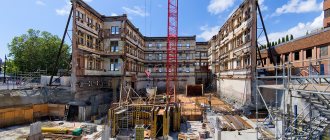To meet the various needs of each person and society as a whole, a wide variety of buildings and structures are erected, differing from each other in their purpose, design, number of floors, material, appearance, burial in the ground and other characteristics and qualities. These two terms are used interchangeably, but their meaning is not the same. What is the difference between a building and a structure and is it important to understand this difference?
Building
Before answering the question of how a building differs from a structure, let’s consider these two concepts separately.
Buildings include above-ground capital structures with internal space and intended for temporary or permanent residence of people and meeting their various needs. The number of floors can be any: from small cottages and dachas to giant skyscrapers and high-rise buildings. Buildings can be used not only for human habitation, but also for agricultural, industrial activities, and various public needs, for example, as a storage facility or warehouse. The most important attribute in this case is the capital structure and long-term operation.
Most often, the interior space of buildings is divided into separate rooms.
What is the difference between an apartment and an apartment? Difference between apartment and apartment
The difference between apartments and apartments also manifests itself for purchasing purposes. The purchase of apartments, as a rule, is of an investment nature, i.e. in most cases they are bought for profit, while the purchase of an apartment has a pronounced social background - accommodation. If the owner of an apartment registers as an individual entrepreneur and declares income from renting out property, then he does not have the right to tax exemption when selling these premises, even if they have been owned for more than 3 years.
How are apartments different from apartments? The fact that the need or possibility of redevelopment of these premises is regulated by the general provisions of the Town Planning Code, according to which permission is not required if the proposed changes do not bring about structural changes and do not change the level of reliability and safety of a non-residential building. And if the lack of permits greatly simplifies the reconstruction of apartment premises, then there are many problems in the organizational features of the functioning of such buildings.
Building classification
Depending on the height of the building there are:
- low-rise (1–3 floors);
- medium height (from 4 to 9 floors);
- multi-storey (from 10 to 16 floors);
- increased number of floors (number of floors 17–25);
- high-rise buildings with more than 25 floors.
Based on their purpose, buildings and structures are divided into 2 groups:
- civil, intended for people to live in and provide for their social, everyday and cultural needs;
- production, providing normal conditions for production processes, serving to protect workers and equipment from atmospheric influences and providing the necessary comfortable working conditions for workers.
What is the difference between renting and hiring?
It is also worth noting that the maximum deadline is five years. But this does not mean that the tenant must then move out of the home. After all, if the landlord decides to continue renting out the apartment, then three months before the document expires, he is obliged to notify the tenant about this. And him first of all, because according to the law he has primary rights to this.
A lease agreement is used only when it comes to any non-residential real estate. And the rent is provided specifically to a legal entity. Then the one who will provide his housing for use will be called the lessor, and the other party will be called the tenant.
Civil buildings
The buildings are divided into:
- Residential buildings.
- Public.
Residential buildings - houses, boarding schools, dormitories, etc.
Public - educational, medical and preventive, scientific, entertainment, communal and other institutions.
A feature of residential and many public buildings is the presence of a large number of separate rooms in a small area. Industrial buildings differ from residential buildings in the presence of large common premises, which are not divided into rooms by partitions and walls and can reach enormous sizes (up to several hectares).
Depending on the material and design, buildings and structures are divided into wooden (frame, block, chopped, panel), brick, stone, concrete and reinforced concrete (large-panel, large-block, volumetric blocks).
The difference between the status of an apartment and a residential premises: what is the difference
I almost bought this myself. All documents are in order. Everything is legalized. But look at the ruling of the Supreme Court of the Russian Federation No. 18-КГ17-21 dated March 21, 2019. Everything is clearly written. Whatever the site was allocated for is what should be built. And the court overturned all legalizations, including the decision of the Regional Court. If you want to live on a legal bomb, live. And then someone will like your land and there is a way to take it away, fortunately there is something to refer to. It worked once, it will work a second time. Without links in the Russian newspaper dated 03/21/2019 issue 7225(59) dated 03/21/2019
We recommend reading: How much do they pay for kindergarten in 2019?
The ending is complete nonsense. There are a lot of apartment buildings that were built without taking into account communications at all and the houses were handed over according to documents, but there are NO communications at all! And I would be interested to see at least one owner of residential premises who would take permission to sell from a neighbor? Actually complete nonsense! There is no need to confuse the share in the room itself! Moreover, if you have a share in an apartment for one of the rooms, then the consent of the neighbors of this very apartment is required. Two troubles, as it was and so it will be.
Industrial buildings and structures
This category includes buildings intended for the needs of industry, transport, energy and providing normal conditions for labor and operation of the located equipment.
Industrial buildings and structures are single-story or multi-story buildings:
- factories and plants;
- hangars;
- bridges;
- towers for television and radio communications, hydraulic structures, overpasses;
- shipbuilding slipways;
- power plants, airfields, spaceports, water towers, etc.
Classification of industrial buildings
Industrial buildings are divided into four main groups:
- Production. This includes buildings that house workshops that produce semi-finished or finished products.
- Auxiliary. These are buildings housing administrative and office premises, household premises and devices, first aid stations and catering facilities.
- Energy. This category includes CHP buildings that supply industrial enterprises with electricity and heat, transformer and electrical substations, boiler rooms, compressor rooms, etc.
- Transport and warehouse buildings. This group includes industrial vehicle parking lots, garages, fire stations, finished product warehouses, etc.
Depending on the number of spans, one-, two- and multi-span industrial buildings and structures are distinguished.
By the number of floors - single-story and multi-story. Today, one-story buildings predominate in construction (approximately 80%). Multi-storey buildings are used in industries with light technological equipment.
Depending on the availability of lifting and transport equipment, industrial buildings and structures are divided into craneless and crane (with suspended or bridge equipment).
Some issues of civil law turnover of real estate
1. When real estate becomes the subject of a lease transaction, you should remember that isolation is a mandatory feature of the objects. Federal Law No. 122-FZ allows for the transfer for temporary possession and use of parts of the premises. However, these parts must be customized. Paragraph 3 of Article 25 of this regulatory document states the need to:
- attach a copy of the cadastral passport to the lease agreement;
- indicate the size of the rented area.
If the agreement does not allow specification of the real estate that is transferred for temporary possession and use (for example, it only states that half of the non-residential premises are rented), and does not contain attachments - diagrams, drawings, such a document is considered invalid.
2. Disputes arise among the owners of non-residential objects, which are located in 1 building, regarding the rights to the common property of the building:
- intended to serve more than 1 isolated space of the room;
- stairs;
- corridors;
- attics;
- halls;
- roofs;
- basements with utilities;
- load-bearing structures, etc.
All legal owners of non-residential premises have the right of shared ownership of property of this type by virtue of law. Disputes about the size of the share are resolved taking into account the area of the real estate of each interested party. Owners of premises in one building can transfer individual structural elements of the building for use, for example, for placing outdoor advertising.
3. If the owner of a building decides to form several non-residential premises - to separate them from the structure of the building, when entering information into the State Property Committee on new objects, the building itself loses the legal status of the real estate as the possible property of 1 person. For cadastral registration of such non-residential premises, one application is submitted. The procedure takes place simultaneously for all new real estate.
4. Non-residential premises in a residential building are an isolated space that is not a home or the common property of the owners. Owners of non-residential properties pay for utilities on a general basis.
Although there is no definition of non-residential premises in regulatory documents, the legislation clearly establishes the characteristics of such objects and regulates the features of their civil legal circulation. This allows economic entities to legally competently organize transactions and defend their rights in relation to non-residential objects.
What is a building?
A structure is a volumetric, linear or planar building system that has underground or above-ground parts. It consists of load-bearing and enclosing building structures and is designed to perform various production processes, temporary stay of people, storage of finished products, movement of goods and people.
There are:
- linear structures - power lines, pipelines, roads;
- venues (stadiums, gyms and airfields);
- deep and underground structures (storages, wells, subways, wells, etc.).
Facilities also include:
- Fences, railings, fences, towers.
- Retaining supports, towers, blocks and pillars.
- Ferry blocks, masts and dams.
- Tunnels, bridges, mines, underground channels and passages.
- Statues, monuments, crosses.
- Other engineering and construction facilities for industrial, military, government or administrative purposes, communication lines, television, radio broadcast systems, heat, power transmission and Internet networks.
All listed objects relate to structures. They perform an auxiliary cultural, religious or technical function in people’s life.
Some additional features of the buildings
The structure can be erected as an independent object, regardless of its future location on the land plot. Any construction object, taken separately, can constitute one overall complete structure, which contains the entire engineering and technical infrastructure. According to their purpose, they can be temporary or long-term and represent either a completed structure or an unfinished one.
Status of residential premises and apartment difference
In fact, the differences are only in the execution of documents: in the Certificate of Ownership of the land plot on which the apartment building with premises in the status of “apartment” is located, the purpose of the land is indicated as “Land of populated areas - apartment building.” If the buyer is offered to purchase residential premises, then the Certificate of Land Title will indicate “Land of settlements - for individual housing construction or for gardening.” Both the premises and the apartment have the same purpose: residential and one can seize this property.
Note. The procedure for recognizing a premises as a residential premises and the requirements that a residential premises must meet, including its adaptation taking into account the needs of people with disabilities, are established by legislative acts of the Russian Federation (Part 3 of Article 15 of the Housing Code of the Russian Federation; Clause 1 of the Regulations, approved by the Decree of the Government of the Russian Federation dated 01/28/2006 N 47).
Hydraulic structures
Hydraulic engineering refers to structures that are used to improve, regulate, redirect water resources and prevent the negative effects of water. These include piers, river dams, canals, hydroelectric power stations, ports, and river backwaters. In addition, there are specialized structures, for example, drainage systems that are used in agriculture, sea and river shipping structures, water pipelines, and settling tanks. All of the above structures are erected according to the development and need of a particular sector of the economy.
Depending on the location, the hydraulic structure can be:
- sea;
- river;
- lake;
- ground;
- underground.
Depending on the type of maintenance of the hydraulic structure, the branches of water management can be:
- water and energy;
- bank protection;
- reclamation;
- water transport.
There are also structures for sewerage, water supply, use of water resources, city improvement, aesthetic and sports purposes.
Comparison
What is the difference between a building and a structure? Today in the legal literature these concepts are used as synonyms. But historically, buildings included those structures that had an above-ground part and separate premises. Used for living, studying, production, sports, etc. Structures - any object erected by man (stadium, firing point, bunker, column, etc.). Structures may be deprived of an above-ground part. We discussed in more detail what a building is and what a structure is in the article. These concepts must be distinguished. According to the practice that has developed over time, construction is a broader concept. Calling a building a structure would not be a mistake.
So, what is the difference between a building and a structure? Let's summarize.
- Special purpose. Buildings are structures adapted for people to live, work and study. Structures are objects that perform technical functions.
- Design. Buildings, unlike structures, always have separate premises and architectural completeness.
- Individual characteristics. Buildings always have an above-ground part that forms their foundation. Structures can be located entirely underground.
Requirements for buildings and structures: functional feasibility, architectural and artistic expressiveness, feasibility of technical solutions, reliability, sanitary and technical requirements taking into account natural, climatic and other local conditions, safety requirements, cost-effectiveness of construction, etc.
Let's analyze residential and non-residential premises or apartments, what is the difference
From established practice, it can be established that a building is a complex real estate property, or rather a complex of real estate, an architectural and construction facility that creates conditions for work, social and cultural services for the population, residence, storage of valuables and consists of walls, a roof, and foundation.
Although the legislation does not contain clear definitions for these concepts, it makes it possible to clearly identify the signs that show the difference between residential and non-residential premises, as well as the signs that characterize the similarities of these two types of premises.











